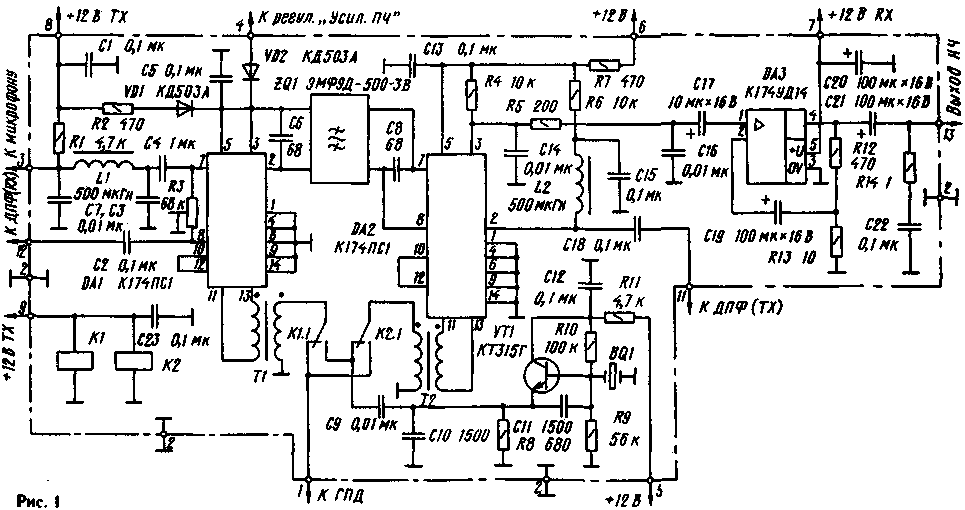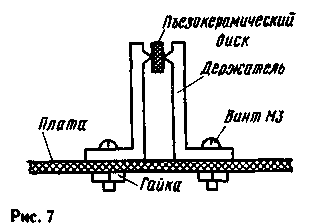
|
|
ENCYCLOPEDIA OF RADIO ELECTRONICS AND ELECTRICAL ENGINEERING Small signal path of the transceiver Amator EMF-M. Encyclopedia of radio electronics and electrical engineering
Encyclopedia of radio electronics and electrical engineering / Civil radio communications The transceiver is designed to operate on the amateur radio bands 160, 80 and 40 meters in CW and SSB modes. The sensitivity of the transceiver with a signal-to-noise ratio of f0 dB is not worse than 1 μV. Selectivity on the mirror channel, not worse than 40 dB. Manual gain control range, not less than 60 dB. Output power at a load of 50 ohms is not less than 8 watts. Suppression of side channels, no worse than 40 dB. The selectivity of the transceiver for the adjacent channel during reception and the amount of suppression of the non-working sideband during transmission are determined by the characteristics of the applied electromechanical filter. In the smooth range generator of the transceiver, an analogue of the lambda diode is used as an active element. The circuit operates at low voltages of 2,5 V and low currents of 200 ... 250 μA. This eliminates the heating of the frequency-setting elements, which in turn leads to a minimum initial frequency overshoot and high stability. The scheme of the small-signal path of the transceiver is shown in Fig. 1. It is based on active balanced mixers made on the K174PS1 type IC. In the receive mode, the signal, having passed the bandpass filters, separate for the receive and transmit modes, is fed to the board's receiving input (pin 12). The first transceiver mixer is assembled on the DA1 chip. Through the contacts of relay K.1 and transformer T1, voltage is supplied to the microcircuit from a smooth range generator of 400 ... 500 mV. The load DA1 is the electromechanical filter ZQ1. From the EMF, the signal is fed to the second mixer, made on the IC DA2. Here, through the contacts of relay K2 and transformer T2, voltage is supplied from a reference frequency generator of 500 kHz. The reference frequency generator is made on the transistor VT1. From pin 3 of the DA2 chip, the low-frequency signal is fed to the bass amplifier on the DA3 chip. In receive mode, it is possible to adjust the IF gain. The adjustment voltage, taken from the variable resistor engine connected to a +12 V power source, is fed to pin 4 of the board. In transmit mode, the signal from the microphone is fed to pin 3 of the board. Through the filter C7, L1, C3, it enters the first mixer on the DA1 chip, where it is mixed with a reference oscillator frequency of 500 kHz. The resulting DSB signal is fed to the ZQ 1 filter, which extracts the single-sideband high sideband signal. Trimmer resistor R3 is used to balance the mixer for maximum carrier suppression. In the mixer on DA2, a single-sideband signal is transferred to one of the frequencies of the amateur radio band. From pin 2 of the DA2 chip, the signal is fed through band-pass band filters to the power amplifier. Relays K1 and K2 switch the signals of the smooth range generator and the reference frequency generator during the transition from reception to transmission. The installation of the low-signal path is carried out on printed circuit board size 130x60mm (Fig. 2) from foil glass-textolite. The location of parts on it is shown in Fig.3. During installation, resistors of the MJIT 0,25 type were used. Capacitors of constant capacity - KM, KLS, electrolytic - K50-16. Transformers T1, T2 are made on ring ferrite (permeability 400-600NN) magnetic cores of size K7x4x2mm. Wire PEV-2 0,2 mm wound 2x30 turns. The path setting has no special features. We will especially talk about the telegraph local oscillator. Many radio amateurs faced the problem of acquiring a quartz resonator for a telegraph signal shaper, a reference oscillator. Despite the fact that in the last decade, radio markets and shops selling almost any radio components have appeared in many cities, the problem has not exhausted itself. What about radio amateurs living far from large cities? In general, they sometimes have to use only what is at hand, soldered from old radio equipment. Meanwhile, the problem turned out to be solvable at home, and a variant of the generator using a home-made resonator is offered to the attention of readers. The device is stable enough to be used as a 500kHz reference oscillator. A piezoceramic filter of the PF1P-2 (PF1P) type can be used to manufacture the resonator. Such a filter was once used in transistor broadcasting receivers "Geologist", "Meridian", "Sport-2", etc. Carefully, with a knife or a hacksaw, we separate the filter cover from the bottom. The filter itself is attached to the bottom with mounting wires, which is a plastic base with eight cells closed by two getinax sidewalls. Between the sidewalls, in the cells, with the help of silver-plated spring washers, piezoceramic discs are fixed. Having carefully drilled out two aluminum rivets that fasten the sidewalls, we disassemble the filter and remove the discs. The filter contains 4 thin discs and 4 thick discs. Thick discs are suitable for making a resonator. The circuit of the CW generator is shown in Fig.4. It is traditional and has no special features. The printed circuit board of the generator is shown in Fig.5.
We make a board and assemble the generator. To attach the resonator to the printed circuit board, you need the parts (2 pcs.) shown in Fig.6. They can be made of phosphor bronze or other springy material. Stepping back 3 mm from the edge of the part (see Fig. 6), with a core or a nail, we make an extract of the metal.
The resulting protrusions are slightly filed with a needle file so that planes with a diameter of 0,5-1 mm are formed. This is necessary for more reliable and uniform contact with the disc. We install the holders on the generator board so that the protrusions are aligned (Fig. 7) and the disk is installed without distortions.
By connecting a frequency meter to the output of the generator and shorting to a common wire, the output of the resistor R3, which is right according to the diagram, we supply power to the circuit. We insert a disk between the holders and measure the frequency of the generator. The resonator frequency is adjusted by reducing the outer diameter of the disk, turning it evenly around the circumference on "zero" sandpaper or using a diamond file. The disk is turned until the generation frequency of 500,7 ... 501 kHz is obtained. Before the next measurement, the disk is wiped with alcohol. It is necessary to control the frequency during the fitting process as often as possible. Using the same technique, it is possible to manufacture reference frequency resonators of 500 kHz and 503,7 kHz. Literature
Author: I. Ptashchik (UY5UM) pos. Bucha, Kyiv region, Ukraine; Publication: N. Bolshakov, rf.atnn.ru
A New Way to Control and Manipulate Optical Signals
05.05.2024 Primium Seneca keyboard
05.05.2024 The world's tallest astronomical observatory opened
04.05.2024
▪ ATA5558 Low Frequency RFID Device ▪ Green energy will cause a crisis of rare metals ▪ Wasteful fuel from the green
▪ section of the site Car. Article selection ▪ article And everything that he saw before him, he despised or hated. Popular expression ▪ article Machinist compressor ZIF-55. Standard instruction on labor protection ▪ article CRT filament protection device. Encyclopedia of radio electronics and electrical engineering ▪ article Evertalking radio. Encyclopedia of radio electronics and electrical engineering
Home page | Library | Articles | Website map | Site Reviews www.diagram.com.ua |






 Arabic
Arabic Bengali
Bengali Chinese
Chinese English
English French
French German
German Hebrew
Hebrew Hindi
Hindi Italian
Italian Japanese
Japanese Korean
Korean Malay
Malay Polish
Polish Portuguese
Portuguese Spanish
Spanish Turkish
Turkish Ukrainian
Ukrainian Vietnamese
Vietnamese




 Leave your comment on this article:
Leave your comment on this article: